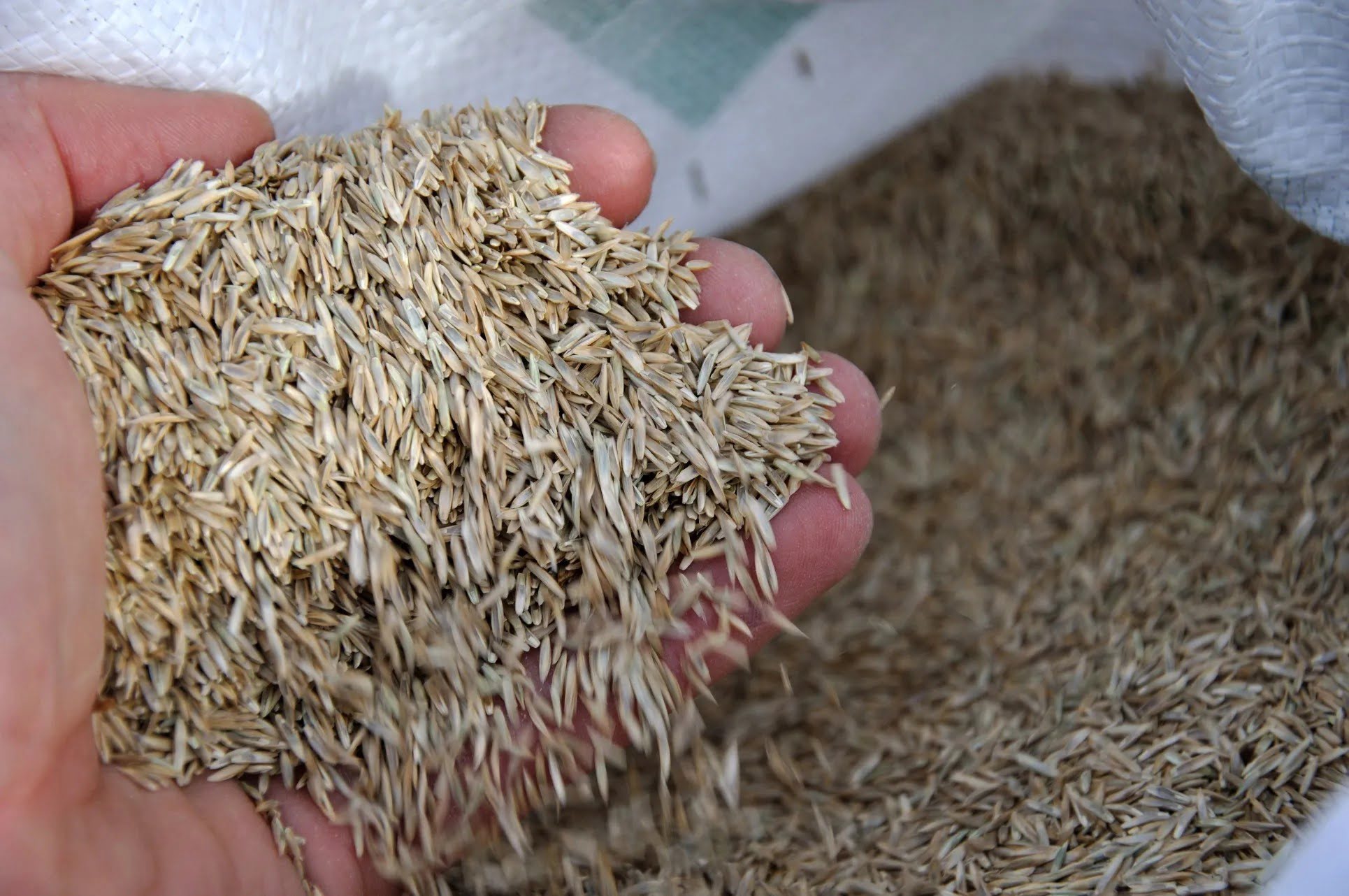Home>Garden Essentials>Why Is Grass Seed So Expensive This Year


Garden Essentials
Why Is Grass Seed So Expensive This Year
Modified: May 6, 2024
Looking to start a garden? Find out why grass seed prices are skyrocketing this year and how it may impact your gardening budget.
(Many of the links in this article redirect to a specific reviewed product. Your purchase of these products through affiliate links helps to generate commission for Storables.com, at no extra cost. Learn more)
Introduction
Gardening enthusiasts and homeowners looking to revive their lawns often turn to grass seed as an essential component. However, you may have noticed that the cost of grass seed has been steadily increasing in recent years. This price hike has left many wondering why this essential gardening supply is becoming more expensive.
Several factors contribute to the rising cost of grass seed. Understanding these factors can provide valuable insight into the current market trends and help you make informed decisions when purchasing grass seed. In this article, we will explore the various reasons behind the increasing prices of grass seed and discuss how these factors impact both suppliers and consumers.
By examining the impact of weather conditions, supply and demand dynamics, transportation and shipping costs, the effects of the pandemic, and changes in consumer behavior, we can gain a comprehensive understanding of why grass seed prices are soaring.
Furthermore, we will discuss the implications of expensive grass seed on the landscaping and gardening industry and provide strategies for dealing with these increased costs. Let’s delve deeper into each of these factors to unravel the mystery behind the rising prices of grass seed.
Key Takeaways:
- 1. Weather, demand, and pandemic impacts drive up grass seed prices. Consider alternatives, plan ahead, and consult professionals to manage costs and create beautiful lawns sustainably.
- 2. Rising grass seed prices challenge consumers and industry. Explore bulk purchases, overseeding, and sustainable options to navigate cost while maintaining attractive outdoor spaces.
Read more: Why Are Patio Sets So Expensive
Factors Affecting Grass Seed Prices
Several key factors contribute to the fluctuations in grass seed prices. Understanding these factors can help us grasp why grass seed is becoming more expensive. Let’s examine each of these factors in detail:
1. Impact of Weather Conditions: Weather conditions, particularly droughts and floods, play a significant role in determining grass seed prices. Adverse weather events can disrupt seed production and reduce the overall supply of high-quality grass seed. When the supply decreases, prices naturally increase to balance the demand and supply equation.
2. Supply and Demand Dynamics: Like any commodity, grass seed prices are influenced by the basic principles of supply and demand. If there is a shortage of grass seed due to poor weather conditions or increased demand, the price tends to rise. On the other hand, if there is an oversupply, prices may decrease. It’s the delicate balance between supply and demand that impacts the pricing of grass seed.
3. Transportation and Shipping Costs: Grass seed production may not always happen close to the end consumer. Long-distance transportation and shipping costs play a significant role in determining the final price. Rising fuel prices and logistical challenges can contribute to increased transportation costs, which are then passed onto consumers.
4. Effects of the Pandemic on Grass Seed Production: The COVID-19 pandemic has had a widespread impact on various industries, including the grass seed industry. Lockdowns, restrictions, and labor shortages have disrupted the production and distribution of grass seed. These challenges have led to a decrease in overall supply, resulting in higher prices.
5. Increase in Raw Material and Production Costs: The cost of raw materials, such as seeds, fertilizers, and pesticides, has been on the rise in recent years. Additionally, the cost of equipment, labor, and other production-related expenses have also increased. These factors contribute to higher production costs, which are eventually reflected in the retail price of grass seed.
6. Changes in Consumer Behavior and Demand: The gardening and landscaping industry has witnessed a surge in demand, driven by homeowners focusing on improving their outdoor spaces. Increased consumer interest in gardening and lawn care has led to heightened demand for grass seed. Higher demand often leads to higher prices as suppliers need to meet the increased consumer expectations.
By understanding these factors, we can gain valuable insights into the reasons behind the rising prices of grass seed. In the next sections, we will explore the specific impacts of these factors on the landscaping industry, as well as strategies you can employ to deal with the expensive costs of grass seed.
Impact of Weather Conditions
Weather conditions play a crucial role in the production and availability of grass seed. The quality and quantity of grass seed produced can be significantly affected by fluctuations in weather patterns. Let’s explore how weather conditions impact grass seed prices:
1. Drought: Drought is one of the most significant weather events that can negatively impact grass seed production. Lack of water can hinder seed germination and growth, resulting in lower yields and reduced seed quality. When drought affects major grass seed production regions, the limited supply drives up prices due to the decreased availability of high-quality seeds.
2. Floods: While drought can harm grass seed production, excessive rainfall and flooding can also have adverse effects. Floods can wash away seeds and damage crops, leading to a decrease in the overall supply of grass seed. This scarcity of seed increases prices as suppliers struggle to meet the demand.
3. Extreme Temperatures: Extreme heat or cold can also impact grass seed production. High temperatures can cause stress to grass plants and reduce seed production, while freezing temperatures can damage or kill the plants, affecting the seed yield. These extreme temperature events can result in lower seed supply and subsequently higher prices.
4. Seasonality: Grass seed availability is often influenced by the seasonality of seed production. Certain grass species have specific seasons in which they produce seeds. If weather conditions during these seasons are unfavorable for seed production, the availability of seeds decreases, leading to higher prices.
5. Climate Change: Climate change has emerged as a significant factor affecting weather patterns worldwide. It brings increased uncertainty and volatility to weather conditions, making it challenging to predict and plan for optimal grass seed production. The unpredictability caused by climate change can disrupt seed supplies and contribute to higher grass seed prices.
These weather conditions have a direct impact on the quality and quantity of grass seed produced. When the supply of grass seed is reduced due to adverse weather events, the demand remains constant or even increases, resulting in higher prices. It is important to keep these weather-related factors in mind when considering the cost of grass seed and planning your lawn care activities.
Supply and Demand Dynamics
The principles of supply and demand play a significant role in determining the pricing of grass seed. Understanding how these dynamics influence the market can shed light on why grass seed prices have been on the rise. Let’s delve into the supply and demand dynamics of the grass seed industry:
1. Supply: The supply of grass seed refers to the quantity of seed available in the market. It is influenced by factors such as weather conditions, crop yields, and production capabilities. When there is a limited supply of grass seed, either due to poor weather conditions or other factors, the price tends to increase as suppliers strive to meet the demand with limited resources.
2. Demand: The demand for grass seed refers to the quantity of seed desired by consumers. Factors such as landscaping trends, consumer preferences, and overall interest in gardening and lawn care influence the demand for grass seed. Higher demand for grass seed can lead to increased prices as suppliers adjust their pricing to meet the heightened consumer interest.
3. Balance: The balance between supply and demand is where the equilibrium price of grass seed is determined. When the supply and demand for grass seed are relatively equal, prices remain stable. However, if the demand surpasses the supply, prices begin to rise as suppliers capitalize on the increased demand. On the other hand, if there is an oversupply of grass seed, prices may decrease to encourage consumer purchases.
4. Market Competition: Competition among suppliers plays a crucial role in determining the pricing of grass seed. When there is healthy competition, suppliers may keep prices competitive to attract customers. However, if a supplier is a dominant player in the market, they may have more control over prices, potentially leading to higher costs for consumers.
5. Seasonal Variations: The demand for grass seed can vary depending on the time of year. Spring and fall are typically the peak seasons for grass seed usage as homeowners focus on lawn renovation and overseeding. During these seasons, when demand is higher, prices may increase due to increased competition among consumers for limited supplies.
These supply and demand dynamics in the grass seed industry can fluctuate based on various factors. External events, such as weather conditions or changes in consumer behavior, can disrupt the delicate balance between supply and demand, leading to pricing adjustments. It is essential for both consumers and suppliers to understand these dynamics to make informed decisions about grass seed purchases and pricing strategies.
Transportation and Shipping Costs
The transportation and shipping of grass seed from its production locations to the end consumers can significantly impact its overall price. Let’s explore how transportation and shipping costs contribute to the increasing prices of grass seed:
1. Distance: Grass seed production may not always be concentrated close to the areas where it is in demand. In many cases, production centers are located in specific regions known for their favorable growing conditions. As a result, seeds need to be transported over long distances to reach consumers. The longer the distance, the higher the transportation costs involved, and these costs are passed on to the consumers.
2. Fuel Prices: The cost of fuel plays a crucial role in determining transportation and shipping costs. Fluctuations in fuel prices can directly impact the overall cost of transporting grass seed. When fuel prices rise, transportation becomes more expensive, and these increased costs are reflected in the prices of grass seed.
3. Logistics and Handling: Proper logistics and handling are required to ensure the safe transportation of grass seed from production centers to retailers or directly to consumers. This includes packaging, storage, loading, unloading, and transportation management. Each step adds to the overall cost of transportation, which is ultimately borne by the consumers.
4. Infrastructure Development: The condition of transportation infrastructure, such as roads, highways, and ports, can also impact transportation and shipping costs. If infrastructure development and maintenance are lacking, it can lead to inefficiencies, delays, and higher costs for transporting grass seed to its destination.
5. International Trade: Grass seed may also be imported from other countries to meet demand or to offer specific varieties that are not locally available. Importing grass seed involves additional costs such as customs duties, tariffs, documentation, and compliance with international regulations. These import costs can contribute to the overall price of grass seed in the market.
6. Supplier Relationships: Transportation costs can also be influenced by the relationship between suppliers and transportation providers. Bulk purchases or long-term partnerships with transportation companies can result in more favorable pricing. Conversely, if suppliers face challenges in securing reliable transportation options, it can lead to increased costs and, subsequently, higher grass seed prices.
Considering these factors, transportation and shipping expenses are an essential component in determining the final cost of grass seed. The longer the distance, the higher the fuel costs, and the complexity of logistics, the more it impacts the overall price. Consumers should be aware that these costs are added to the production and supply chain, ultimately influencing the retail price of grass seed.
Read more: Why Are Pillows So Expensive
Effects of the Pandemic on Grass Seed Production
The COVID-19 pandemic has had widespread effects on various industries, and the grass seed production sector is no exception. The pandemic has disrupted the normal operations of the industry, creating a ripple effect that can be felt in the prices of grass seed. Let’s explore some of the key effects of the pandemic on grass seed production:
1. Labor Shortages: The pandemic has caused significant disruptions in labor availability. Lockdowns, travel restrictions, and social distancing measures have made it challenging for farms and production facilities to operate at full capacity. Labor shortages have impacted grass seed production, leading to decreased output and, consequently, higher prices due to limited supply.
2. Production Delays: The pandemic has disrupted the entire production process, from seed harvesting to packaging and distribution. Delays in production have resulted from restrictions on the movement of workers, disruptions in the supply chain, and temporary closures of production facilities. These delays have led to a decrease in the availability of grass seed, contributing to increased prices.
3. Fluctuating Demand: The pandemic has caused shifts in consumer behavior, with more people spending time at home and focusing on their outdoor spaces. This has led to increased demand for grass seed as homeowners invest in lawn care and landscaping projects. The sudden surge in demand has put additional pressure on the already constrained supply, leading to higher prices.
4. Export and Import Challenges: The pandemic has also caused disruptions in global trade. Restrictions on international travel, closures of borders, and changes in import and export regulations have made it difficult to move grass seed across borders. These challenges have limited both the import of grass seed from other countries and the export of domestically produced seed, impacting overall supply and increasing prices.
5. Supply Chain Disruptions: The pandemic has disrupted the entire supply chain, from raw materials to the final delivery of grass seed products. Interruptions in the supply chain have resulted in increased costs associated with sourcing materials, packaging, transportation, and fulfilling orders. These increased costs are eventually passed on to the consumers through higher prices.
6. Uncertainty and Speculation: The pandemic has created a sense of uncertainty, making it challenging for producers to accurately forecast demand and plan for production. This uncertainty has led to speculation in the market, with suppliers taking precautions by increasing prices to mitigate potential risks. This speculation adds to the overall increase in grass seed prices.
The effects of the pandemic on grass seed production have been multifaceted, impacting both the supply and demand sides of the industry. Labor shortages, production delays, fluctuating demand, export and import challenges, supply chain disruptions, and uncertainty have all contributed to the increasing prices of grass seed. While the industry is gradually recovering, it is important for consumers to anticipate and understand these effects when making decisions about purchasing grass seed.
Consider buying grass seed in bulk or looking for sales and discounts at local garden centers or online retailers. You can also consider alternative options such as overseeding or using a combination of grass seed and other ground cover options to save money.
Increase in Raw Material and Production Costs
Raw materials and production costs are significant factors that contribute to the rising prices of grass seed. Several factors have led to an increase in these costs, ultimately impacting the final retail price of grass seed. Let’s explore these factors in detail:
1. Seed Costs: The cost of grass seed itself is a primary component in the production expenses. Breeders and suppliers invest in research and development to create and maintain new grass seed varieties with improved traits, such as disease resistance and drought tolerance. The investment in seed development and the cost associated with producing and obtaining quality grass seed contribute to higher raw material costs.
2. Fertilizers and Pesticides: The use of fertilizers and pesticides is essential in the production of healthy and high-quality grass seed. However, the prices of these inputs have been steadily increasing in recent years. Rising costs of fertilizers and pesticides directly impact the production expenses, leading to higher overall costs of grass seed.
3. Labor Expenses: Labor costs are a significant part of any production process, including grass seed production. Wages, benefits, and operational expenses associated with employing workers have been on the rise. Additionally, labor shortages, as experienced during the pandemic, can further increase labor expenses. These factors contribute to higher production costs that are eventually reflected in the retail price of grass seed.
4. Machinery and Equipment: Grass seed production requires specialized machinery and equipment for tasks such as planting, harvesting, cleaning, and packaging. The cost of acquiring, maintaining, and operating this machinery adds to the production expenses. These costs are then factored into the final price of grass seed.
5. Research and Development: Ongoing research and development efforts to improve grass seed varieties and production techniques require significant investment. Innovation in this field is essential to meet evolving consumer demands and to develop seeds that are resistant to diseases, pests, and environmental stresses. The costs associated with research and development contribute to the overall increase in raw material and production costs.
6. Sustainable Practices: The adoption of sustainable agricultural practices, such as organic farming and environmentally friendly production methods, can increase production costs. Implementing these practices often requires additional effort, resources, and certifications, which add to the overall expenses of grass seed production.
The increase in raw material and production costs directly impacts the prices of grass seed. Suppliers, in order to cover their expenses and maintain profitability, pass on these increased costs to consumers. It’s important for consumers to be aware of these factors when evaluating the price of grass seed and to weigh them against the benefits and quality of the product.
Changes in Consumer Behavior and Demand
Consumer behavior and demand have a significant impact on the pricing of grass seed. The shifts in consumer preferences and behavior can drive both the supply and demand sides of the market, influencing the overall cost of grass seed. Let’s explore some of the key changes in consumer behavior and their impact on the demand for grass seed:
1. Increased Focus on Outdoor Spaces: With more people spending time at home and seeking to improve their living environments, there has been a noticeable increase in the demand for outdoor spaces. Homeowners are now investing in their gardens, lawns, and landscaping to create beautiful and functional outdoor areas. This increased focus on outdoor spaces has led to higher demand for grass seed as consumers look to establish or renovate their lawns.
2. Emphasis on Environmental Sustainability: Many consumers today are conscious of environmental impact and strive to make sustainable choices. This has led to a growing interest in eco-friendly lawn care practices. As a result, there is an increased demand for grass seed that is bred and produced using sustainable methods. Suppliers who specialize in sustainable grass seed may have higher production costs, which can influence the retail price when catering to this specific consumer demand.
3. Desire for Low-Maintenance Lawns: Busy lifestyles and the desire for low-maintenance outdoor spaces have influenced consumer demand. Homeowners are seeking grass seed varieties that require minimal watering, mowing, and upkeep. The demand for low-maintenance grass seed has prompted breeders to develop and offer seed varieties with these characteristics. The additional research and development costs associated with producing these varieties can impact the overall pricing of the seed.
4. Seasonal Demand Fluctuations: The demand for grass seed may fluctuate seasonally, with peak demand occurring during the spring and fall when homeowners often undertake lawn renovation or overseeding projects. The increased demand during these periods can impact the pricing of grass seed as suppliers need to manage the limited supply and balance it with the higher demand. This can result in higher prices during peak seasons.
5. Gardening and Landscaping Trends: Consumer preferences are also influenced by gardening and landscaping trends. Certain grass seed varieties may gain popularity due to their visual appeal, drought resistance, or other desirable features. As trends change and specific grass seed varieties become more in demand, their prices may increase due to limited supply or increased production costs.
6. COVID-19 Pandemic Effects: The COVID-19 pandemic has influenced consumer behavior, including an increased interest in home improvement projects and outdoor activities. The focus on enhancing outdoor spaces has driven up demand for grass seed as consumers look to create or improve their lawns and gardens. The sudden surge in demand, coupled with production challenges during the pandemic, has contributed to higher prices of grass seed.
These changes in consumer behavior and demand have a direct impact on the pricing of grass seed. Suppliers and breeders strive to meet the evolving expectations of consumers, but in doing so, they may incur additional costs, such as research and development expenses or offering specialized varieties. These costs are then reflected in the final retail price of grass seed.
Impact on the Landscaping and Gardening Industry
The increasing prices of grass seed have had a significant impact on the landscaping and gardening industry. Professionals, homeowners, and businesses that rely on grass seed for various projects have been affected in several ways. Let’s explore the impact of rising grass seed prices on the landscaping and gardening industry:
1. Higher Project Costs: Landscaping and gardening projects that involve the use of grass seed now come with higher price tags. The increased cost of grass seed directly affects the overall budget of projects, making it more expensive to establish or renovate lawns and landscapes. This can make it challenging for homeowners and businesses to undertake large-scale projects that require substantial amounts of grass seed.
2. Adaptation of Landscaping Strategies: Landscape designers and professionals have had to adapt their strategies to accommodate the rising prices of grass seed. They may recommend alternative approaches, such as incorporating more native vegetation or using turf alternatives, to reduce the reliance on costly grass seed. This adaptation ensures that landscaping projects are still feasible and aesthetically appealing despite the increased costs.
3. Focus on Sustainable Landscaping: The increase in grass seed prices has prompted a greater emphasis on sustainable landscaping practices. Homeowners and businesses are seeking ways to minimize water usage, reduce the need for chemical inputs, and choose varieties that are well-suited to local climate conditions. This shift toward sustainable landscaping helps mitigate the impact of higher grass seed prices and aligns with environmental conservation efforts.
4. Impact on Lawn Care Businesses: Companies in the lawn care industry, such as lawn maintenance and landscaping services providers, have felt the effects of rising grass seed prices. Higher costs for grass seed directly impact their operational expenses. These businesses may need to reevaluate their pricing structures or find ways to streamline their operations to ensure their services remain affordable and competitive.
5. Consumer Decision-Making: Homeowners and individuals looking to purchase grass seed for DIY projects are also impacted by the rising prices. They may need to carefully consider the costs associated with grass seed and explore alternative options or adjust their project plans accordingly. The increased prices may influence their decision-making process, leading them to consider different grass seed varieties or scaling down their lawn projects.
6. Innovation in Lawn Care Products: The higher prices of grass seed have pushed industry manufacturers to innovate and develop alternative lawn care products. This includes options such as synthetic turf, which eliminates the need for grass seed altogether, or seed alternatives that offer quick germination and establishment. These innovations provide consumers with alternatives that aim to balance cost and aesthetic preferences.
Overall, the increase in grass seed prices is causing a ripple effect throughout the landscaping and gardening industry. It necessitates adaptations in strategies, a focus on sustainability, and careful consideration of costs. Nevertheless, the industry continues to evolve, embracing alternative solutions and finding ways to provide appealing outdoor spaces despite the challenges posed by rising grass seed prices.
Read more: Why Are Mirrors So Expensive
Strategies for Dealing with Expensive Grass Seed
Navigating the landscape of expensive grass seed prices can be challenging, but there are strategies you can employ to deal with the increased costs. Whether you’re a homeowner or a professional in the landscaping industry, consider the following strategies to help manage the expenses associated with grass seed:
1. Assess Your Needs: Take the time to assess your specific lawn care needs. Determine the size of the area that requires grass seed and consider the specific characteristics you desire, such as drought tolerance or low-maintenance options. By understanding your needs, you can make informed decisions about the quantity and type of grass seed required, avoiding unnecessary expenses.
2. Research Alternative Seed Varieties: Explore different grass seed varieties that may be more affordable while still meeting your lawn care requirements. Look for grass seed options that are locally-adapted or native to your area, as they tend to be more cost-effective. Additionally, consider seed mixtures that contain a blend of grass species, as they might offer a balance between durability, appearance, and affordability.
3. Consider Seed Alternatives: In some cases, it might be worthwhile to explore seed alternatives. Synthetic turf or sod can provide an instant lawn without the need for grass seed. While these options may have higher upfront costs, they can save you money in the long run, as they require less ongoing maintenance and seed purchases.
4. Utilize Overseeding Techniques: Overseeding involves spreading grass seed over an existing lawn to promote thickening and rejuvenation. Instead of completely reseeding your lawn, overseeding can be a cost-effective way to fill in bare spots and improve the overall appearance and health of your grass. Focus on overseeding high-traffic or problem areas, rather than reseeding the entire lawn.
5. Consult with a Professional: If you’re unsure about the best approach for dealing with expensive grass seed, consider consulting with a professional landscaper or lawn care specialist. They can assess your lawn, recommend suitable alternatives, and provide guidance on cost-effective approaches based on their expertise and experience.
6. Implement Proper Lawn Care Practices: Maintain proper lawn care practices to ensure your grass seed investment thrives. Water your lawn efficiently by following appropriate watering schedules and techniques. Proper mowing and fertilization can also support healthy growth and reduce the need for excessive grass seed applications over time.
7. Buy in Bulk: If you have a large lawn or multiple lawn care projects, consider purchasing grass seed in bulk. Buying in larger quantities can help you take advantage of discounts and save on the cost per pound. However, ensure that you have the means to store the excess seed properly to maintain its viability.
8. Plan Ahead: Plan your lawn care projects well in advance to take advantage of seasonal sales and promotions. Grass seed prices may fluctuate throughout the year, with peak seasons often resulting in higher prices. By planning ahead, you can secure your seed during more cost-effective periods.
These strategies can help you navigate the challenges of expensive grass seed prices while still achieving an attractive and healthy lawn. Remember, every lawn is unique, and finding the right balance between cost and quality is essential. By being proactive and exploring different options, you can manage the expenses associated with grass seed and create beautiful outdoor spaces within your budget.
Conclusion
The rising prices of grass seed have presented challenges for both consumers and the landscaping and gardening industry. The various factors discussed, including weather conditions, supply and demand dynamics, transportation costs, pandemic impacts, and increased raw material and production costs, have all contributed to the overall increase in grass seed prices.
Despite these challenges, there are strategies available for dealing with expensive grass seed. Understanding your specific needs, researching alternative seed varieties, considering seed alternatives like synthetic turf or sod, and utilizing overseeding techniques can help manage costs. Consulting with professionals, implementing proper lawn care practices, buying in bulk, and planning ahead are additional strategies to navigate the realm of expensive grass seed.
As the landscaping and gardening industry adapts to the changing market dynamics, a focus on sustainable practices, innovation in lawn care products, and accommodating consumer preferences for low-maintenance and environmentally friendly solutions will continue to shape the industry’s response to rising grass seed prices.
Ultimately, finding the right balance between quality, cost, and aesthetics is crucial when choosing grass seed. Assessing your unique lawn care needs, exploring affordable seed options, and making informed decisions about alternative approaches can help you create and maintain beautiful outdoor spaces without breaking the bank.
In conclusion, while the prices of grass seed may continue to rise, the landscaping industry and consumers can adapt and navigate these challenges by prioritizing sustainability, exploring cost-effective alternatives, and employing strategies tailored to their specific needs. By being proactive and knowledgeable, it is possible to strike a balance between a stunning lawn and managing expenses in the world of expensive grass seed.
Now that you've got the scoop on why grass seed prices have spiked, consider diving deeper into eco-friendly gardening practices with our next feature on sustainable landscaping. As budgets tighten and environmental awareness grows, learning about low-impact gardening methods not only helps your wallet but also the planet. Perfect for both novices and seasoned gardeners, this article promises practical insights into making your green space both beautiful and sustainable.
Frequently Asked Questions about Why Is Grass Seed So Expensive This Year
Was this page helpful?
At Storables.com, we guarantee accurate and reliable information. Our content, validated by Expert Board Contributors, is crafted following stringent Editorial Policies. We're committed to providing you with well-researched, expert-backed insights for all your informational needs.














0 thoughts on “Why Is Grass Seed So Expensive This Year”